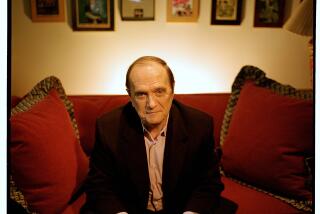Rosebud
- Share via
It is difficult to like William Randolph Hearst. It is not difficult, however, to admire, indeed, thoroughly to enjoy this magisterial new biography of Hearst, the first in 40 years, based upon a wide array of new sources. Hence the tension of this new biography: the implicit struggle of David Nasaw, professor of history at City University of New York Graduate Center, to penetrate the enigma of a figure who remains perhaps the greatest unknown Great Unknown in American history and certainly a figure with whom it is nearly impossible for the average American to attain some point of common sympathy, despite the fact that Hearst based his career on a unique ability to reach the masses.
What a paradox! Born to privilege, literally with the silver spoon of the Nevada Comstock in his mouth, scion of one of the great fortunes to emerge from the Far Western mining frontier, William Randolph Hearst shunned his own class, at least as far as social identification was concerned, and instead embraced--indeed, helped bring into being--a mass public of ordinary Americans whom he beguiled across six decades with headlines (most of them misleading), scandals (most of them violent or sexual or both), movies (some of them good, most of them terrible), magazines (most of them still publishing) and allied media, including an early interest in radio. A man who ransacked Europe for art, importing whole monasteries back to the United States, stone by stone; refurbishing an English castle; filling warehouses in New York and San Francisco with objets d’art bought so precipitately and on such a wholesale basis that they remained crated for decades--this very same figure achieved his greatest power in effecting a connection with the ordinary American, whom he managed to beguile and entertain while suggesting, simultaneously, that he, the little guy, was getting screwed by the system.
Over the years, many commentators, historians and biographers have sought to deconstruct and analyze the Hearst enigma, beginning with muckraker Lincoln Steffens, who in the early 1900s first saw Hearst as the Great Unknown of American public life. Hearst himself commissioned a vanity biography in the 1920s. In 1940, Orson Welles stunned the film world--and certainly stunned Hearst--with the path-breaking “Citizen Kane”; however displaced in its content, the film nevertheless went to the heart of the Hearst enigma and in its own way drove into that heart an interpretive and mythopoeic stake that 60 years have not managed to remove.
The very title of the last major biography before this one--”Citizen Hearst” (1961) by W.A. Swanberg--testifies to the Neal Gabler-esque primacy of Welles’ film, in which the life became the movie and the movie in turn became the life.
Not so with “The Chief.” This biography, years in the making, is based upon an entirely new array of primary sources, including a cache of letters discovered in a bunkhouse at San Simeon. Nasaw, in fact, who writes with the verve of a first-rate reporter, achieves much of his narrative through quotations from previously inaccessible letters, especially from Hearst’s earlier years. Our time is emerging as a golden age of American history and biography; and Nasaw’s “The Chief” is part of a larger pattern of extraordinarily well-researched books of American history and biography, based on new sources, envisioned and executed in the grand spirit of the 19th century novel. As the American novel, in fact, has become more narrow, more internal and fragmented, more solipsistic in its inability to grasp and refract social dynamics in the manner of the 19th century’s masters--indeed, in the manner of John Dos Passos, John O’Hara and John P. Marquand--American historians and biographers have come to the fore as providers of imaginative as well as social scientific interpretation.
Nasaw’s “The Chief” works on a large, even heroic, canvas and, thanks to Nasaw’s exhaustive research, moves on a level of detail that would satisfy even Theodore Dreiser. “The Chief,” in fact, is replete with extraordinary moments that are at once historical and suggestive of that Great American Novel that once haunted the imagination of our writers but which they have now put aside, temporarily, as unattainable.
In capturing so well so many revealing moments, Nasaw lays down a track of discourse paralleling not only the novel that Dreiser might have written but also the film that Welles acted in and directed. We have the boy, the only son of a late marriage (late on his father’s part, at least), a father ever absent in the mining regions of the Far West; and the boy, remaining at home with his mother in San Francisco or down the peninsula in cosseted circumstances, the two of them growing so close in their isolation that the boy absorbed his mother’s fierce passion for art in a way that, after her death in 1919, would lead the middle-aged son to build the castle in Spain and the California Xanadu, San Simeon, as a materialization of the palaces of art the two of them had explored together through their long sojourn in Europe when he was 10 and 11: sojourns he would repeat again and again throughout his life as if to recapture the rosebud of those years together.
Raised by his mother, ignored by his father, Hearst becomes a lifelong lover of women: not in the free-ranging manner of the sensualist seducer roue but as a man who moved from a mother’s love to an early impossible love with an aspiring actress to a longtime relationship with a Cambridge waitress whom he met while a Harvard undergraduate and kept in dignity for more than a decade to a love affair with a charming chorus girl of 16, whom he married, who bore his sons and became a leader of New York society and, of course, to the actress Marion Davies, also a lady of the chorus, a woman of great heart with an only now acknowledged comic talent. Hearst loved women, but he loved only a few of them and one at a time, and he left each of them wealthy, and Nasaw is excellent in depicting these relationships.
In the well-known story of Hearst and the Spanish American War, Nasaw offers grave qualifications to the canard that Hearst started the war in the first place. He offers us, in recompense, however, the sight of Hearst in a white yachtsman’s uniform taking his yacht down to Cuba as a rich man’s ship-of-the-line, the counterpart to Teddy Roosevelt’s Rough Riders uniform from Brooks Brothers.
Then there is Hearst the politician. So fixed is our image of Hearst as media mogul that we forget just how close he came to becoming, at various times, mayor of New York City, governor of New York state and, on two occasions, the Democratic nominee for vice president and president of the United States. So fixed, moreover, is our perception of Hearst as the right-wing isolationist zealot of the 1930s that we forget that he was a lifelong Democrat and in his early years a Progressive Reformer of some repute. All this is superbly treated by Nasaw.
*
And then there is Hearst the newspaperman: bursting into the pressroom of the New York American in the late hours in formal evening wear, fresh from an evening at the theater, a chorus girl or two in tow, rewriting headlines, demanding new layouts--then off to a late-night spot with the chorines and a handful of other newspaper cronies, some of them hangers-on from San Francisco--for a late night of champagne and cigars. This depiction of Hearst as robust New Yorker from the fin de siecle--a lover of terrapin suppers at Delmonico’s, a nightly habitue at the Ziegfeld Follies or the latest musical by Victor Herbert, a man who stayed up all night and slept until noon and ran with a ratpack of laughing retainers--almost makes Hearst likable, given the ominousness of his later image when, always dressed in black, unsmiling and stoic, his blue-gray eyes fixed in a piercing gaze, he seemed (to Steffens) at least to embody the possibilities of dictatorship in these United States.
In one sense, we already know the story that Nasaw will tell, even before we begin his dazzling book. The Hearst story, after all, has become part of American folklore. It has become, in fact, one of the prisms through which Americans glimpse the quality and meaning of their national and local experience, especially in the way that entertainment values--and Hearst was first and foremost the entertainer--have come not only to pervade but to structure our journalism, our politics and, after a century of shtick, the manner in which every Rotary leader conducts his or her weekly meeting.
It is in this theme--the creation of a new media consciousness, based on entertainment values and extending through an interactive print-image nexus--that Nasaw makes his most valuable contribution to our understanding of what Hearst achieved as, in a very true sense, he emerged as our first modern media mogul, with his early rival Joseph Pulitzer running in not-so-close second place.
Virtually inventing the headline as the young publisher of the San Francisco Examiner, Hearst grasped the histrionic possibilities of type itself. Under his guidance, the very letters of the alphabet were restored to their primal power, as if once more liberated from the ancient inscriptions of the classical Mediterranean and pre-classical Near East. The very invention of the comic strip and its instant popularity with the working masses seemed to connect modern life with the lost world of hieroglyphics and runic inscriptions.
From there, Hearst edged into motion pictures, most dramatically the newsreel, which he practically invented. These newsreels, in effect, brought Hearst’s newspapers into even further motion, blending them into the real world so that what was achieved in the Hearst media empire was an interactive, sometimes even self-referencing, world. History as fact, history as print, history as comic strip, history as newsreel and history as motion picture (Hearst also pioneered the historical costume film and loved masquerade balls) were feeding into each other to create a special space, a Hearstian space, that was at once fact and fiction, print and image, sound and meaning.
Despite his New York years, Hearst returned to California when his dreams of elective office collapsed. He became increasingly interested in Hollywood, led there not only by the interests of Davies but also by his almost titanic understanding of the power of film not only to entertain but also to structure and format real life, as Gabler has recently suggested. Nasaw’s “The Chief” brings us to a new understanding of just how important Hearst was in the creation of Hollywood, in which he was no mere interloper but a silent and dominant partner, among other things, in the emergence of the studio system.
Like so many California Progressives, Hearst grew rabidly isolationist in the 1920s and 1930s: another paradox given his obsession with European art, his 300-plus-room English castle, his almost yearly caravan tours in a procession of grand automobiles through the European countryside. Interestingly enough, a number of younger counter-factual historians are today agreeing with Hearst in his belief that World War I was an unnecessary catastrophe in European terms, a killing machine for young men in terms of Europe and the Commonwealth and, in American terms, a sucker-punch by the Anglo American establishment at the expense of a significantly German American and Irish American nation. And yet, despite his growing conservatism and isolationism, Hearst seemed untouched by the virus of anti-Semitism that also pervaded this country in the aftermath of World War I. He was, indeed, something of a philo-Semite whose newspapers long enjoyed the support of the urban Jewish middle and lower-middle classes.
Hearst remains hard to like, finally, because he accumulated so much power at the expense of others, including any bank foolish enough to lend him money. He was, simply, a narcissist and a spendthrift, a parvenu and a philistine, a source of ceaseless agitation and a bully. He was also a genius of sorts: a man who continues to fascinate the collective American imagination because in the sprawling panorama of his life and achievement, we can see the beginnings of those media consolidations, that rage for entertainment, that equation of boredom with death itself that has so profoundly conditioned modern life.
More to Read
Sign up for our Book Club newsletter
Get the latest news, events and more from the Los Angeles Times Book Club, and help us get L.A. reading and talking.
You may occasionally receive promotional content from the Los Angeles Times.







